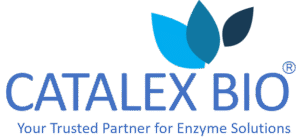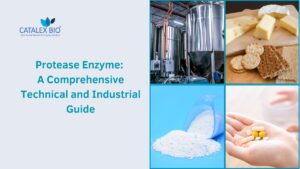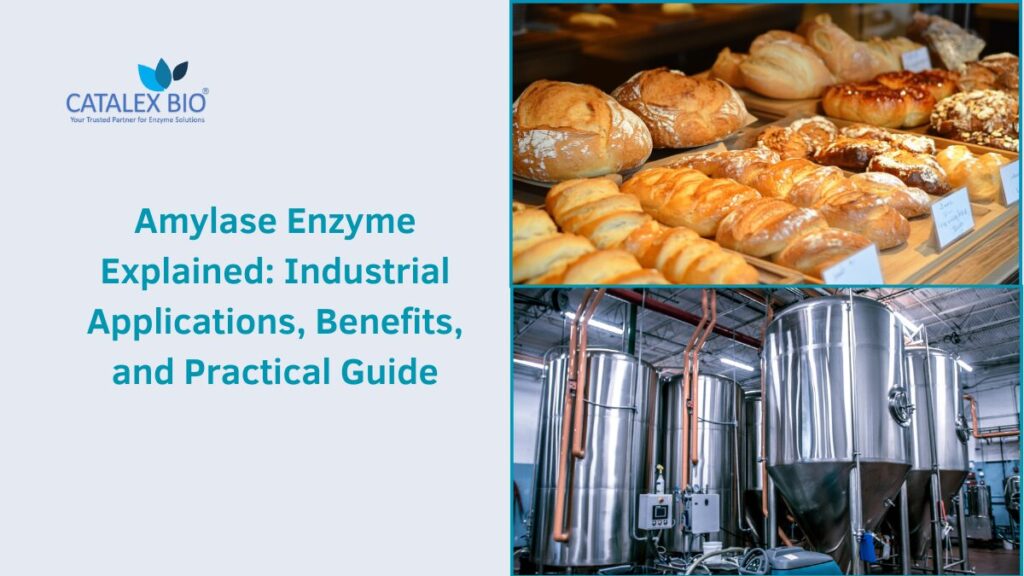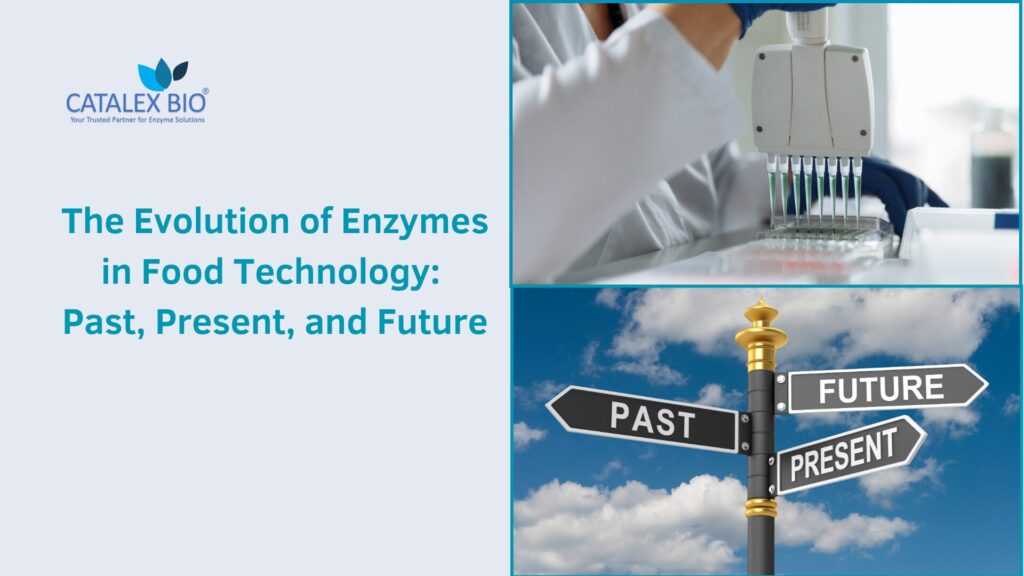1. Introduction
Enzymes are at the heart of modern industrial biotechnology, replacing harsh chemical treatments with eco-friendly, highly efficient, and selective biocatalysts. Among them, Proteases (EC 3.4.x.x)—also known as proteinases or peptidases—hold a dominant position. These enzymes hydrolyze peptide bonds in proteins, breaking them into smaller peptides and amino acids. Their ability to act on diverse protein substrates has made proteases the single largest segment in the global industrial enzyme market, accounting for nearly 60% of enzyme sales worldwide.
Proteases are indispensable across industries such as detergents, food and beverages, dairy, brewing, baking, pharmaceuticals, leather, textiles, animal feed, and waste management. They not only serve in traditional processes like cheese-making and meat tenderization but also power high-performance detergents, eco-friendly leather processing, protein hydrolysate production, and therapeutic formulations.
Why Proteases Are Unique
- Versatility of Action: Depending on their catalytic mechanism, proteases may use serine, cysteine, aspartic acid, or metal ions in their active sites to catalyze hydrolysis.
- Wide pH and Temperature Range: From acid proteases (active at pH 2–5) to alkaline proteases (active at pH 9–11), proteases can function under extreme conditions, allowing tailored use across industries.
- Natural Abundance: Found in microorganisms, plants, and animals, proteases are essential for life—supporting digestion, cellular regulation, and protein turnover.
- Industrial Dominance: While animal- and plant-derived proteases (e.g., pepsin, papain, bromelain) have historical relevance, today’s industrial demand is met largely by microbial proteases due to their scalability, stability, and cost-effectiveness.
Microbial proteases, particularly from Bacillus (bacterial) and Aspergillus (fungal) species, dominate industrial use thanks to their scalability, low cost, and adaptability through fermentation and genetic engineering. Plant-derived proteases like papain (from papaya) and bromelain (from pineapple) remain niche but valuable for tenderization and pharmaceutical use
At Catalex Bio, we deliver high-quality protease solutions tailored to industry-specific requirements. Our portfolio includes fungal and bacterial proteases, as well as plant derived proteases (bromelain and papain), optimized for detergent, food, feed, beverages, nutraceutical, cosmetics, pharmaceuticals and leather sectors. Backed by technical expertise, robust supply chains, and regulatory compliance, we ensure consistency and efficiency for industrial partners.
This article offers a comprehensive technical and practical guide to Protease, covering:
- History and discovery of protease
- Structure and catalytic mechanisms
- Sources of protease (fungal, bacterial, plant, animal, biotech)
- Industrial applications across multiple sectors
- Comparison between fungal and bacterial proteases
- Units of activity and assay methods
- Practical user guidance for industries
- Future outlook and innovations in protease biotechnology
2. History and Discovery of Protease
The history of proteases reflects humanity’s long-standing relationship with protein processing — from ancient food preparation techniques to modern industrial biotechnology.
Early Observations (18th–19th Century):
- 1836: The first protease, pepsin, was discovered in gastric juice by Theodor Schwann, establishing the concept of protein-digesting enzymes.
- 1874: Trypsin was identified from pancreatic extracts, confirming the existence of distinct proteases in animals.
- Throughout the 19th century, plant-derived proteases like papain (from papaya latex) and bromelain (from pineapple) were used in traditional medicine and food tenderization.
Early 20th Century:
- Fungal and bacterial proteases were recognized for their ability to hydrolyze proteins under fermentation conditions, paving the way for industrial applications.
- Neutral and alkaline proteases from Bacillus species were first characterized, demonstrating stability under high pH and temperature.
Mid 20th Century – Industrial Adoption:
- Food and brewing: Fungal proteases became widely used in cheese making, soy sauce fermentation, and beer brewing.
- Detergents: The detergent industry revolutionized cleaning by incorporating alkaline bacterial proteases in the 1960s, enabling effective stain removal at moderate wash conditions.
- Leather processing: Enzymatic bating and dehairing replaced toxic chemicals like lime and sulfide.
Late 20th Century – Enzyme Biotechnology Era:
- Microbial fermentation made large-scale protease production feasible.
- Immobilized proteases were introduced for continuous hydrolysis processes.
- Recombinant DNA technology enabled tailored proteases with improved thermostability and substrate specificity.
Present Day:
- Advanced tools like directed evolution, protein engineering, and metagenomics are delivering customized proteases for specific applications — from sustainable detergents to peptide-based pharmaceuticals.
3. Structure and Mechanism of Protease Action
3.1 Protease Classification by Catalytic Mechanism
Proteases are classified into families based on their active-site residues and catalytic strategies:
- Serine proteases (e.g., subtilisin, trypsin): Use serine in the active site; widespread in detergents and food industries.
- Cysteine proteases (e.g., papain, bromelain): Employ cysteine; important in meat tenderization, pharmaceuticals, and cosmetics.
- Aspartic proteases (e.g., pepsin, rennin): Use aspartic acid residues; widely applied in dairy and beverage industries.
- Metalloproteases (e.g., thermolysin, collagenase): Require metal ions such as Zn²⁺; critical in collagen degradation and bioprocessing.
3.2 Catalytic Mechanism of Protease Action
Proteases hydrolyze peptide bonds by:
- Substrate recognition – binding to the protein’s peptide chain.
- Nucleophilic attack – active-site residues or metal ions destabilize the peptide bond.
- Transition state formation – intermediates stabilized by the enzyme.
- Bond cleavage – peptide bond is hydrolyzed, releasing shorter peptides or amino acids.
- Enzyme regeneration – protease returns to active state for successive reactions.
This catalytic efficiency enables proteases to operate under varied industrial conditions, including extreme pH, temperature, or solvent-rich environments.
3.3 Factors Affecting Protease Activity
- pH: Acid proteases (optimum pH 3–5), neutral proteases (pH 6–8), alkaline proteases (pH 8–11).
- Temperature: Bacterial proteases (thermostable up to 70–80°C) vs. fungal proteases (30–55°C).
- Metal ions: Calcium stabilizes many bacterial proteases; EDTA-sensitive metalloproteases require Zn²⁺.
- Substrate specificity: Some are broad-spectrum; others highly selective.
- Solvent/oxidant tolerance: Critical for detergent and textile applications.
4. Sources of Protease
Proteases are ubiquitous in nature—present in microorganisms, plants, and animals—reflecting their fundamental role in protein metabolism. However, for industrial purposes, the primary supply today comes from microbial fermentation, due to superior scalability, consistency, and cost-effectiveness.
4.1 Fungal Sources
Fungal proteases are widely used in food, beverage, brewing, and dairy industries. They thrive in acidic to neutral environments, making them ideal for controlled processing under mild conditions.
- Aspergillus oryzae – A GRAS organism producing neutral proteases; extensively used in soy sauce, miso, and sake fermentation.
- Aspergillus niger – Produces both acid and neutral proteases; used in dairy protein hydrolysis, beverage clarification, and baking.
- Rhizopus species – Sources of acid proteases for cheese production and protein hydrolysis.
- Mucor miehei – Used in milk clotting enzymes (rennet substitutes) for cheese making.
Key Advantage: Fungal proteases are generally food-grade, stable at acidic pH, and recognized as safe, making them indispensable in food biotechnology.
4.2 Bacterial Sources
Bacterial proteases dominate detergent, leather, textile, and waste treatment industries due to their high stability under alkaline conditions and elevated temperatures.
- Bacillus subtilis – Produces neutral and alkaline proteases, applied in detergents, animal feed, and food hydrolysis.
- Bacillus licheniformis – A major source of alkaline protease (subtilisin type), widely used in detergents, leather processing, and silk degumming.
- Bacillus pumilus – Produces highly thermostable proteases for detergents and industrial cleaning.
- Streptomyces griseus – Source of neutral proteases used in meat processing and pharmaceuticals.
Key Advantage: Bacterial proteases are alkaline-stable, thermotolerant, and oxidation-resistant, making them suitable for heavy-duty industrial processes.
4.3 Plant Sources
Proteases are naturally abundant in many plants, where they play roles in defense and seed germination. Historically, plant proteases were among the first enzymes used in food and medicine.
- Papain (from papaya latex) – Widely used in meat tenderization, brewing, digestive aids, and pharmaceuticals.
- Bromelain (from pineapple stem/fruit) – Used in meat tenderization, anti-inflammatory supplements, and cosmetics.
- Ficin (from fig latex) – Applied in tenderizing and beverage clarification.
Limitation: Extraction from plants is low-yield and variable, making microbial fermentation more attractive for large-scale supply. Plant proteases remain niche for specialty food, nutraceutical, and medical applications.
4.4 Animal Sources
Animal-derived proteases played a critical role in the early enzyme industry, but today their industrial role is limited due to ethical, cost, and supply constraints.
- Pepsin (from stomach lining of pigs) – Used in digestive aids, protein hydrolysate production, and pharmaceuticals.
- Trypsin & Chymotrypsin (from pancreas of cattle/pigs) – Applied in pharmaceuticals, diagnostics, and peptide synthesis.
- Rennin/Chymosin (from calf stomach) – Traditionally used in cheese making; now largely replaced by microbial or recombinant sources.
Current Use: Animal proteases are largely restricted to medical, diagnostic, and niche food applications.
4.5 Modern Biotechnology Sources
Advances in biotechnology and protein engineering are revolutionizing protease production:
- Recombinant DNA Technology:
- E. coli, Pichia pastoris, and GRAS fungi express engineered proteases at high yield.
- Example: Recombinant chymosin is now the global standard for cheese rennet.
- Immobilized Proteases:
- Enzymes bound to carriers (e.g., silica, polymers) for continuous processing in food and pharma.
- Benefits: Reusability, reduced costs, stable performance.
- Protein Engineering & Directed Evolution:
- Tailor proteases for oxidative stability (detergents), reduced bitterness (food hydrolysates), and substrate specificity (pharma).
- Example: Oxidation-resistant subtilisin variants for modern laundry detergents.
Overall: While proteases occur across nature, microbial fermentation (fungal and bacterial) remains the backbone of industrial protease production, supported by biotechnological innovations.
5. Industrial Applications of Protease
Protease is the largest-selling industrial enzyme globally, representing nearly 60% of the enzyme market. Its ability to hydrolyze peptide bonds in proteins under mild, eco-friendly conditions makes it indispensable across industries. Proteases not only improve process efficiency but also enable sustainable alternatives to harsh chemicals.
5.1 Detergent Industry
Proteases are the backbone of modern detergents, where they are used to break down protein-based stains such as blood, milk, grass, egg, and sweat.
- Bacterial alkaline proteases (subtilisin type) from Bacillus licheniformis and Bacillus subtilis dominate this segment.
- They remain active under detergent conditions: high alkalinity (pH 9–11), high temperatures (40–60 °C), and presence of surfactants/oxidizers.
- Proteases are combined with lipases, amylases, and cellulases to form multi-enzyme detergent systems.
Benefits:
- Effective stain removal at lower wash temperatures → energy savings.
- Gentle on fabrics compared to harsh chemical oxidizers.
- Compatible with liquid and powder formulations.
- Environmentally friendly, biodegradable alternative to chemical stain removers.
5.2 Food and Dairy Industry
Proteases play a central role in flavor, texture, and protein modification in food systems.
A. Dairy and Cheese Production
- Chymosin (rennet) and microbial proteases hydrolyze casein in milk for curdling and cheese formation.
- Recombinant chymosin (from Aspergillus niger or Kluyveromyces lactis) is now widely used.
- Proteases also generate flavor compounds during cheese ripening.
- Fungal proteases soften gluten networks in dough, improving extensibility and handling.
- Controlled protease action enhances dough relaxation for crackers and biscuits.
C. Brewing and Beverage Processing
- Proteases degrade haze-forming proteins in beer and juices.
- Papain, bromelain, and fungal proteases are used for chill-proofing beer.
D. Protein Hydrolysates and Nutraceuticals
- Proteases hydrolyze proteins (casein, soy, whey, meat, fish) into bioactive peptides.
- Applications: infant formula, clinical nutrition, sports supplements, flavor enhancers.
5.3 Leather and Textile Industry
Proteases have revolutionized eco-friendly leather and textile processing by replacing harsh chemicals.
Leather Applications
- Dehairing and bating: Alkaline proteases remove hair and non-collagenous proteins from hides.
- Improve hide softness, grain quality, and reduce pollution compared to lime/sulfide methods.
Textile Applications
- Proteases are used in wool processing to prevent shrinkage (“biopolishing”).
- Applied for silk degumming, replacing chemical solvents.
Benefits:
- Cleaner effluents, reduced chemical loads.
- Better product quality and higher environmental compliance.
5.4 Pharmaceutical and Medical Industry
Proteases are critical in drug synthesis, formulations, and therapeutic products.
- Trypsin and chymotrypsin – used in wound debridement and anti-inflammatory therapies.
- Papain and bromelain – marketed as nutraceuticals for digestive health and anti-inflammatory properties.
- Proteases as biocatalysts – catalyze stereospecific hydrolysis in the synthesis of chiral drug intermediates.
- Collagenases – applied in tissue dissociation for medical research and in wound healing products.
Benefits:
- High selectivity, mild processing.
- Biocompatible and aligned with green chemistry.
5.5 Animal Feed Industry
Protease supplementation improves protein utilization in feed for poultry, swine, and aquaculture.
- Hydrolyzes complex proteins into absorbable amino acids.
- Enhances feed conversion ratio (FCR) and growth performance.
- Reduces anti-nutritional factors in soybean meal.
- Bacterial alkaline proteases withstand pelleting temperatures in feed processing.
Benefits:
- Improved nutrient absorption.
- Reduced nitrogen excretion → lower environmental pollution.
- Cost-effective use of alternative protein sources.
5.6 Textile & Wool Processing
Proteases are used in wool shrink-proofing by partially hydrolyzing keratin scales.
- Prevents felting and enhances softness.
- Safer and more eco-friendly than chlorine-based methods.
5.7 Brewing and Alcoholic Beverage Industry
Proteases eliminate haze-causing proteins in beer and wine.
- Papain and fungal proteases are used for “chill-proofing.”
- Neutral proteases improve yeast nutrition by generating peptides during fermentation.
5.8 Waste Management and Environmental Biotechnology
Proteases play a vital role in bioremediation of protein-rich wastes.
- Applied in effluents from slaughterhouses, food processing, and tannery wastewater.
- Break down proteins into amino acids, lowering COD (Chemical Oxygen Demand) and BOD (Biological Oxygen Demand).
- Used in sewage treatment formulations with multi-enzyme blends (protease + lipase + amylase).
Benefits:
- Cleaner wastewater streams.
- Reduced environmental footprint of protein-rich industries.
5.9 Cosmetics and Personal Care
Proteases are finding applications in skin care and hair care formulations.
- Papain, bromelain, and keratinases are used in exfoliation and anti-aging products.
- Proteases assist in gentle removal of dead skin cells and enhance penetration of active ingredients.
- Keratinases are explored for hair conditioners and dye formulations.
Benefits:
- Mild, non-toxic, biodegradable ingredients.
- Growing demand in natural and green cosmetics.
6. Fungal vs. Bacterial Protease: Detailed Comparison
Both fungal and bacterial proteases are widely used in industry, but they differ significantly in pH range, temperature tolerance, substrate specificity, and suitability for various applications. Understanding these differences helps industries choose the right enzyme source.
Parameter Comparison
| Parameter | Fungal Protease | Bacterial Protease |
|---|---|---|
| Source | Aspergillus niger, Aspergillus oryzae, Rhizopus, Mucor miehei | Bacillus subtilis, Bacillus licheniformis, Bacillus pumilus, Streptomyces |
| Optimal pH | Acidic to neutral (pH 3.0–7.0) | Neutral to alkaline (pH 7.0–11.0) |
| Temperature Range | 25–50 °C (some stable up to 55 °C) | 35–70 °C (thermophilic strains stable >80 °C) |
| Substrate Preference | Casein, milk proteins, food proteins | Broad spectrum: blood, keratin, gluten, collagen, food proteins |
| Applications | Food & beverage (cheese, brewing, baking), dairy hydrolysis, protein hydrolysates | Detergents, leather, feed, textile, wastewater, pharmaceuticals |
| Advantages | – GRAS status (safe for food use) – Acid-stable – Good flavor control | – Thermostable, alkaline-stable – Robust in detergents – High productivity |
| Limitations | – Sensitive to high temperature & pH extremes – Slower growth in fermentation | – Lower substrate specificity – Some require calcium/metal stabilization |
Rule of Thumb for Industry Users
- Use fungal proteases when working in food, dairy, brewing, and nutraceutical industries, where mild conditions and GRAS status are important.
- Use bacterial proteases for detergents, leather, textiles, feed, and wastewater treatment, where robustness, alkaline stability, and heat tolerance are critical.
7. Units of Protease Activity Measurement
Like other industrial enzymes, protease activity is expressed in terms of the amount of substrate hydrolyzed (or product released) under defined conditions of pH, temperature, and substrate type. Since proteases act on complex proteins, several standardized activity units are used across industries.
7.1 Common Units of Protease Activity
- IU (International Unit)
- 1 IU = the amount of enzyme that hydrolyzes 1 µmol of peptide bonds (or releases 1 µmol of product) per minute under defined conditions.
- Widely used in research and pharmaceuticals.
- Anson Unit (AU)
- Based on casein digestion.
- 1 AU = the amount of enzyme that liberates 1 µmol of tyrosine per minute from casein under specific conditions.
- Traditional, still used for industrial proteases.
- HUT (Hemoglobin Unit Tyrosine Base)
- Measures tyrosine release from hemoglobin under controlled conditions.
- Common for fungal proteases in food applications.
- SAPU (Spectrophotometric Acid Protease Unit)
- For acid proteases, especially in food and dairy.
- Based on hydrolysis of casein at acidic pH, measured spectrophotometrically.
- PC (Protease Casein Unit)
- Based on casein hydrolysis at neutral to alkaline pH.
- Used in detergents and feed industries.
- CDU (Casein Digestion Unit)
- Based on the amount of tyrosine released from casein per minute under standard assay conditions.
- Often used for alkaline proteases in detergents and industrial applications.
- MCU (Milk Clotting Unit)
- Specific to milk-clotting enzymes (like chymosin, fungal rennets).
- Defined as the amount of enzyme that clots a standard milk substrate in a set time.
- Common in dairy industry for rennet and cheese-making enzymes.
- Vendor-Specific Units
- Many enzyme suppliers define proprietary activity units, optimized for their assay methods.
- These may not be directly interchangeable with IU, HUT, or CDU without conversion factors.
7.2 Which Units Are Most Common in Industry?
- Food & Dairy → MCU, HUT, SAPU, Anson units.
- Detergents → CDU, PC, or proprietary alkaline protease units.
- Pharmaceuticals/Nutraceuticals → IU, Anson units.
- Animal Feed → PC, CDU, or vendor-specific units.
8. How Protease Activity is Measured (Assay Methods)
Protease activity assays quantify the ability of an enzyme to hydrolyze peptide bonds in proteins. Unlike lipases, which target ester bonds, protease assays typically focus on protein substrates (casein, hemoglobin, gelatin, milk proteins) and measure the release of peptides or amino acids (often tyrosine equivalents). The choice of assay depends on the source of protease, application, and industry standards.
8.1 Casein Digestion Assay (Anson Method, CDU Units)
- Principle: Protease hydrolyzes casein, releasing soluble peptides (including tyrosine). The liberated tyrosine is measured colorimetrically using Folin–Ciocalteu reagent.
- Unit Basis: Anson Units (AU) or Casein Digestion Units (CDU).
- Usage: Gold standard for alkaline and neutral proteases in detergents, feed, and industrial enzymes.
- Pros/Cons: Highly reliable, but time-consuming compared to rapid spectrophotometric assays.
8.2 Hemoglobin Hydrolysis Assay (HUT Units)
- Principle: Protease hydrolyzes hemoglobin under controlled conditions, releasing tyrosine equivalents.
- Unit Basis: Hemoglobin Unit Tyrosine (HUT).
- Usage: Common for fungal proteases used in food and beverage applications.
- Pros/Cons: Sensitive and reproducible, but less suitable for routine industrial QC.
8.3 Milk-Clotting Activity (MCU Units)
- Principle: Measures the time taken by a protease (e.g., chymosin, microbial rennet) to coagulate standard milk.
- Unit Basis: Milk Clotting Units (MCU).
- Usage: Dairy industry for rennet and cheese-making enzymes.
- Pros/Cons: Application-specific, but critical for standardizing rennet potency.
8.4 Spectrophotometric Assays (Chromogenic Substrates)
- p-Nitroanilide (pNA) Substrates: Proteases release p-nitroaniline, measured at 410 nm.
- Fluorogenic Substrates: Release of fluorescent groups (e.g., AMC from peptide-AMC substrates).
- Usage: Pharmaceutical R&D, diagnostics, high-throughput screening.
- Advantage: Rapid, sensitive, and adaptable for automation.
8.5 Gelatin and Keratin Assays
- Principle: Protease hydrolyzes gelatin or keratin substrates. Activity is measured by viscosity reduction, turbidity change, or soluble peptide release.
- Usage: Specialized for leather, textile, and keratinase applications.
- Pros/Cons: Useful for application-specific testing, but not standardized across industries.
8.6 Plate Assays (Qualitative Screening)
- Casein Agar or Gelatin Agar Plates: Clear zones around microbial colonies indicate protease activity.
- Usage: Screening of protease-producing microbes in biotech and academic labs.
- Limitation: Qualitative, not quantitative.
9. Practical Guidance for Enzyme Users
Successful application of proteases in industrial processes requires careful selection of enzyme source, accurate dosing, and proper handling. Proteases are powerful biocatalysts, but their performance can vary widely depending on substrate, pH, temperature, and formulation conditions. Below are practical considerations for industries using proteases.
1. Choose the Right Source
- Fungal proteases → Food, dairy, brewing, baking, and nutraceuticals where acidic/neutral pH, GRAS status, and controlled activity are needed.
- Bacterial proteases → Detergents, leather, textiles, feed, and wastewater where alkaline stability and robustness are critical.
- Plant proteases (papain, bromelain, ficin) → Niche use in meat tenderization, beverages, and nutraceuticals.
- Recombinant proteases → High-purity, consistent enzymes for pharmaceuticals and specialty food applications.
2. Confirm Activity Units
- Protease activity may be reported in IU, Anson Units, HUT, SAPU, CDU, MCU, or PC units.
- Always check the assay method used by your supplier.
- Request a conversion factor when comparing across vendors. Misaligned units can lead to under- or over-dosing.
3. Run Pilot Trials
- Protease activity varies with substrate type (casein, gluten, keratin), pH, temperature, and cofactors.
- Conduct small-scale pilot trials before full-scale implementation to optimize dosage and performance.
- Pay special attention to bitterness in protein hydrolysates — enzyme choice and hydrolysis degree are critical.
4. Optimize Enzyme Blends
Proteases often combined with amylases, lipases, and cellulases for detergents, feed, or food hydrolysis.
5. Storage and Stability
- Store protease powders and granules in cool, dry conditions (<25 °C).
- Avoid moisture exposure, which can trigger premature activity.
- Liquid protease formulations should be kept sealed and refrigerated if recommended.
- Under proper storage, expect <10% activity loss annually.
6. Safety and Handling
- Protease powders can cause respiratory sensitization if inhaled.
- Use PPE (gloves, masks, goggles) when handling concentrated enzymes.
- Avoid direct skin or eye contact.
- Follow the supplier’s MSDS (Material Safety Data Sheet) guidelines for safe handling.
7. Regulatory Compliance
- Food and feed proteases must be GRAS (Generally Recognized as Safe) or approved by EFSA, FDA, FSSAI, or equivalent authorities.
- Ensure suppliers provide Certificates of Analysis (CoA) and regulatory documentation.
10. Future Outlook and Innovations
Proteases will continue to drive growth in industrial biotechnology due to sustainability and green chemistry goals. Key trends:
- Genetic & Protein Engineering: Directed evolution and site-directed mutagenesis produce proteases with extreme stability, substrate selectivity, and resistance to oxidants/solvents.
- Immobilized Proteases: Allow continuous use in hydrolysis, peptide production, and bioreactors, cutting costs.
- Synthetic Biology: Recombinant production in optimized hosts (Bacillus, Pichia) increases yield and enables discovery of novel proteases from extremophiles.
- New Applications:
- Bio-based plastics recycling.
- Medical proteases for cancer therapy, wound healing, and drug delivery.
- Functional foods and nutraceuticals (peptide-rich hydrolysates).
- Alignment with UN Sustainable Development Goals (SDGs): Proteases reduce chemical use, improve energy efficiency, and support sustainable industrial growth.
11. Conclusion
Proteases have established themselves as the most dominant and versatile enzyme group in biotechnology, driving innovations across detergents, food, dairy, brewing, baking, pharmaceuticals, leather, textiles, feed, cosmetics, and waste management. Their ability to hydrolyze proteins under mild and eco-friendly conditions has made them indispensable to industries seeking efficiency, sustainability, and cost-effectiveness.
- Fungal proteases excel in food and beverage applications, offering GRAS status, flavor control, and activity at acidic/neutral pH.
- Bacterial proteases dominate heavy-duty industries like detergents, leather, and textiles due to their thermostability, alkaline tolerance, and robustness.
- Plant proteases (papain, bromelain, ficin) remain valuable in meat tenderization, beverages, nutraceuticals, and pharmaceuticals.
- Recombinant and engineered proteases are shaping the future, delivering tailored activity, stability, and high yields.
Understanding assay methods, activity units (HUT, Anson, CDU, MCU, IU), and application-specific requirements is crucial for achieving optimal results. With proper selection, dosing, storage, and regulatory compliance, proteases can maximize process performance while reducing environmental impact.
At Catalex Bio, we are committed to supporting industries with scientifically validated protease solutions, backed by technical expertise, regulatory assurance, and reliable global supply. Whether you are formulating detergents, brewing beverages, producing cheese, developing protein hydrolysates, manufacturing pharmaceuticals, or processing leather, our protease enzymes are designed to deliver performance, consistency, and sustainability you can trust.
👉 Get in touch with Catalex Bio today to explore our protease portfolio or discuss customized enzyme solutions for your specific industrial processes.




Pingback: How Enzymes Replace Harsh Chemicals in Industry | Catalex Bio
Pingback: Bromelain Enzyme (Pineapple Protease): Industrial Applications & Technical Guide